
Dish, Salem, North Carolina, 1775–1795. Lead-glazed earthenware. D. 13". (Courtesy, Old Salem Museums & Gardens; unless otherwise noted, photos by Gavin Ashworth.)

Dish, probably southern Alamance County, North Carolina, 1790– 1820. Lead-glazed earthenware with polychrome slip decoration. D. 10". (Courtesy, Old Salem Museums & Gardens.)

L. F. Schmuz, View of Herrnhut, Dresden, Germany, 1775–1800. Engraving on paper. 17 x 21 1/4". (Courtesy, Old Salem Museums & Gardens; photo, Wesley Stewart.)

Christian Gottlieb Reuter, Map of Wachovia, Salem, North Carolina, 1766. Ink and watercolor on paper. 18 1/2 x 11 3/8". (Courtesy, Unity Archives, Herrnhut.)

A Compleat Map of North Carolina from an Actual Survey, published by John Collett, London, 1770. The red line shows the approximate boundaries of the Wachovia tract. (Courtesy, Old Salem Museums & Gardens.)
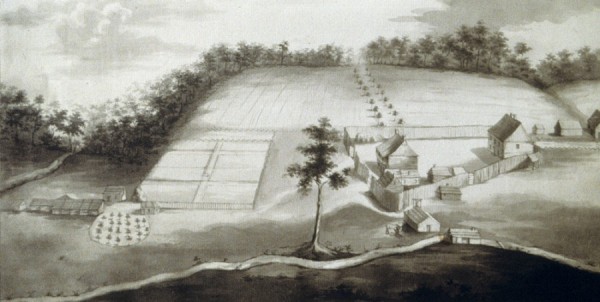
Prospect of Bethabara, Bethabara, North Carolina, ca. 1757. Drawing on paper. 10 1/2 x 14 3/4". (Courtesy, Moravian Archives, Herrnhut.)

Detail of Prospect of Bethabara showing Aust’s pottery shop at the corner of the fort.
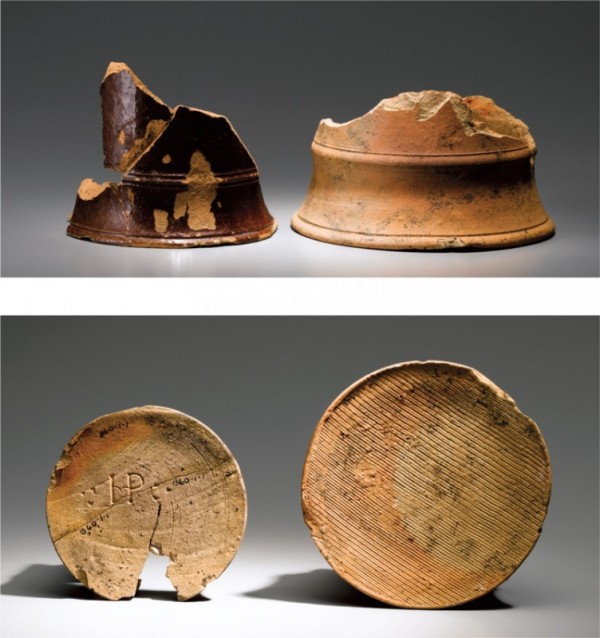
Composite illustration showing glazed and bisque mug fragments recovered at Gottfried Aust’s pottery site, Bethabara, North Carolina, 1756–1770. H. 3 3/8" (glazed on left). (Courtesy, Old Salem Museums & Gardens.) The base on the left is coated with an iron-bearing lead glaze, whereas the base on the right received only a bisque firing. The bottom of the glazed mug is incised with a mark that appears to be the letters H and P conjoined. These mug fragments are probably similar to those used for Love Feast, a religious service that included a simple meal of bread and coffee or tea. Most of the artifacts excavated at Bethabara are housed at Old Salem Museums & Gardens under a custodial agreement between that institution Historic Bethabara Park, and the Southern Province of the Moravian Church. Artifacts in the archaeological collection of Historic Bethabara Park are identified by that organization’s name in the credit line.
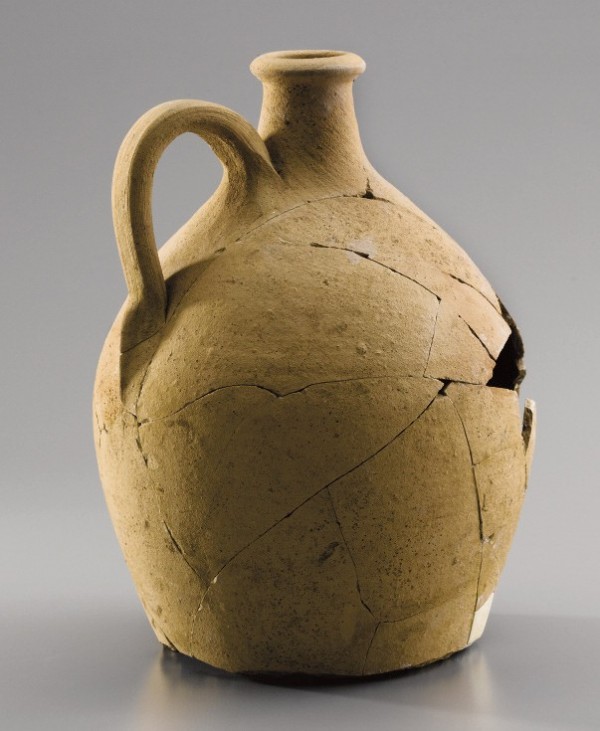
Jug, recovered at Gottfried Aust’s pottery site, Bethabara, North Carolina, 1756–1770. Bisque-fired earthenware. H. 8 3/4". (Courtesy, Historic Bethabara Park.)

Funnel, recovered at Gottfried Aust’s pottery site, Bethabara, North Carolina, 1756–1770. Lead-glazed earthenware. H. 6 3/8". (Courtesy, Historic Bethabara Park.)

Cook pot, recovered at Gottfried Aust’s pottery site, Bethabara, North Carolina, 1756–1770. Lead-glazed earthenware. H. 5". (Courtesy, Old Salem Museums & Gardens.)

Base and top of a candlestick and a fat lamp, recovered at Gottfried Aust’s pottery site, Bethabara, North Carolina, 1756–1770. Bisque-fired earthenware (candlestick fragments) and lead-glazed earthenware (lamp). H. 4 3/4"(lamp). (Courtesy, Historic Bethabara Park.)
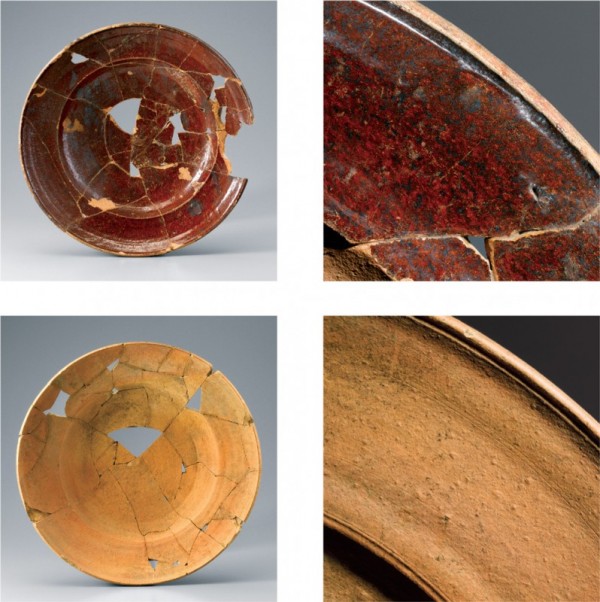
Composite illustration showing overalls and marly details of bisque-fired and lead-glazed dishes recovered at Gottfried Aust’s pottery site, Bethabara, North Carolina, 1756–1770. D. 14 3/4" (top), 12 1/4" (bottom). (Courtesy, Old Salem Museums & Gardens.)

Detail showing the back of the bisque-fired dish illustrated in fig. 13.

Teabowl, recovered at Gottfried Aust’s pottery site, Bethabara, North Carolina, 1756–1770. Bisque-fired earthenware. D. 3 3/8". (Courtesy, Historic Bethabara Park.)

Teapots, attributed to Gottfried Aust’s pottery, Bethabara, North Carolina, 1756–1770. Lead-glazed earthenware. (Courtesy, Historic Bethabara Park [left], Old Salem Museums & Gardens [center], and private collection [right].) The archaeological examples were recovered at Aust’s site; the example at the far right descended in a family from Randolph County, North Carolina.
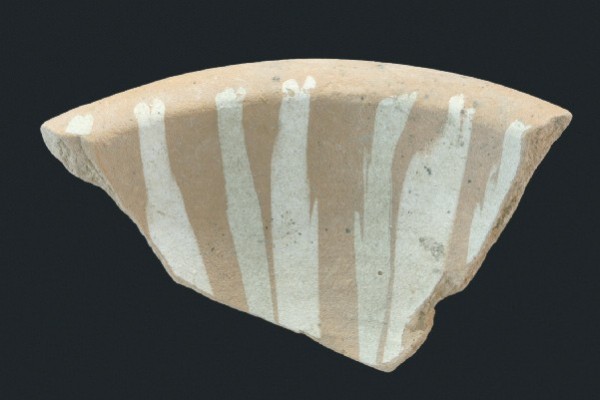
Bowl fragment, recovered at Gottfried Aust’s pottery site, Bethabara, North Carolina, 1756–1770. Bisque-fired earthenware. (Courtesy, Historic Bethabara Park; photo, Wesley Stewart.) When successfully glazed and fired, this example would have resembled the bowl illustrated in fig. 18, right.

Slip-decorated bowls, Bethabara or Salem, North Carolina, ca 1785 (left); Bethabara, North Carolina, 1786–1789 (right). Lead-glazed earthenware. D. 6". (Private collection [left]; Courtesy, Old Salem Museums & Gardens [right].) The archaeological example on the right was recovered from the site of the gunsmith’s shop at Bethabara and probably was made by Rudolph Christ, although Gottfried Aust produced similar examples, as illustrated in fig. 17.
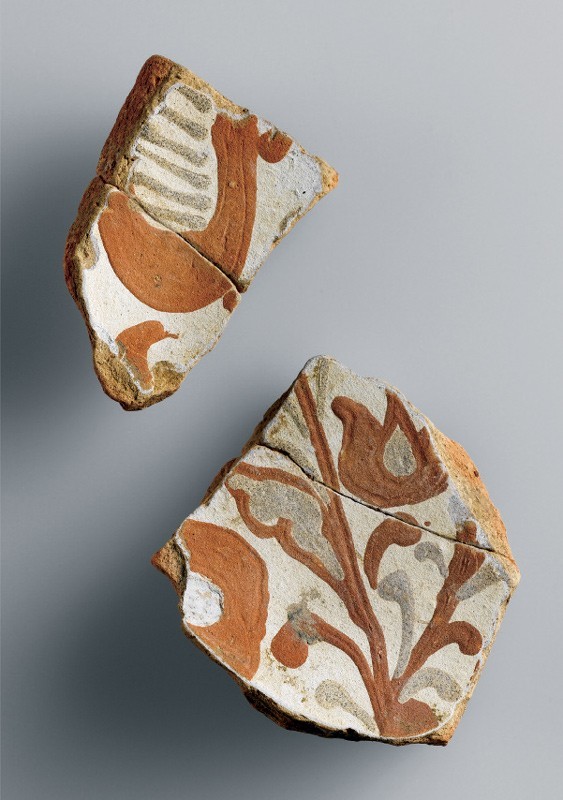
Dish fragments, recovered at Gottfried Aust’s pottery site, Bethabara, North Carolina, 1756–1770. Bisque-fired earthenware. (Courtesy, Historic Bethabara Park.)
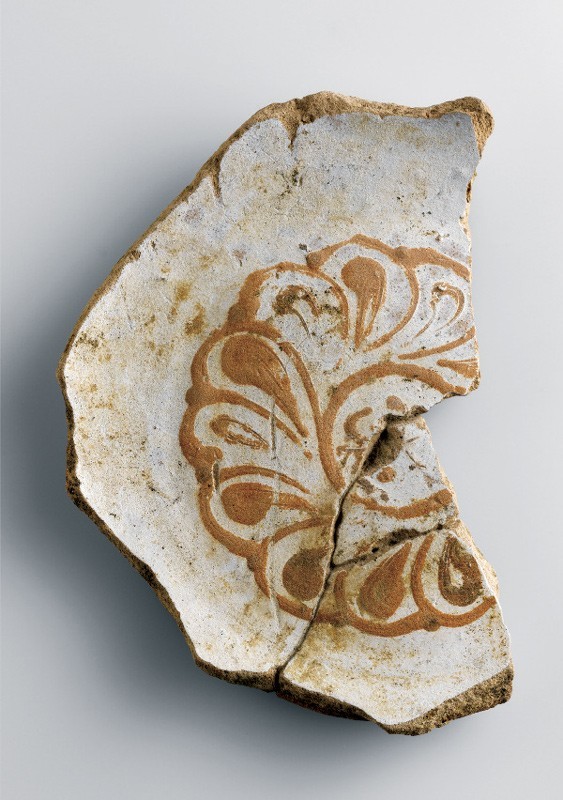
Dish fragment, recovered at Gottfried Aust’s pottery site, Bethabara, North Carolina, 1756–1770. Bisque-fired earthenware. (Courtesy, Historic Bethabara Park.)

Dish, Germany, 1740–1760. Lead-glazed earthenware. D. 12 1/2". (Courtesy, Old Salem Museums & Gardens.)
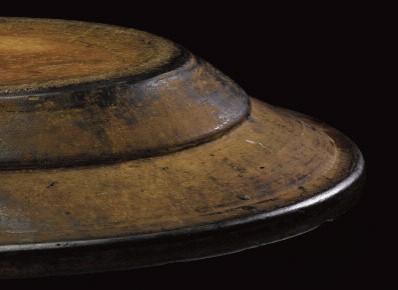
Detail of the back of the dish illustrated in fig. 21.

Ludwig Gottfried von Redeken, A View of Salem in North Carolina, 1788. (Courtesy, Old Salem Museums & Gardens; photo, Wesley Stewart.)
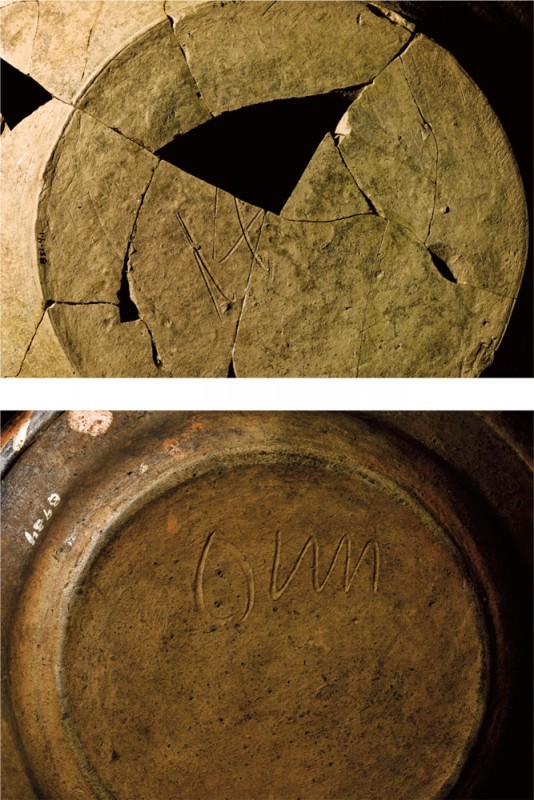
Details of marks on a dish made at Bethabara (top) and a dish made at Salem (bottom). (Courtesy, Old Salem Museums & Gardens.)
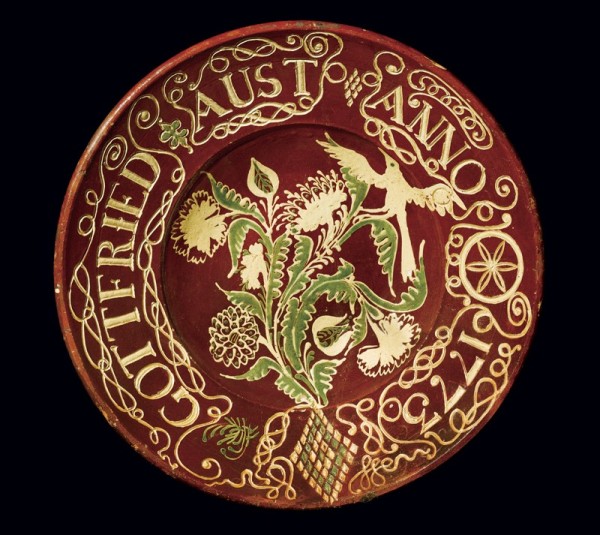
Shop sign made during Aust’s tenure as master of the pottery at Salem, North Carolina, 1773. Lead-glazed earthenware. D. 21 3/4". (Courtesy, Wachovia Historical Society.) Attached to the back are two clay lugs pierced to receive the cord from which the sign hung. The exceptional condition of this object suggests that it hung inside Aust’s shop.
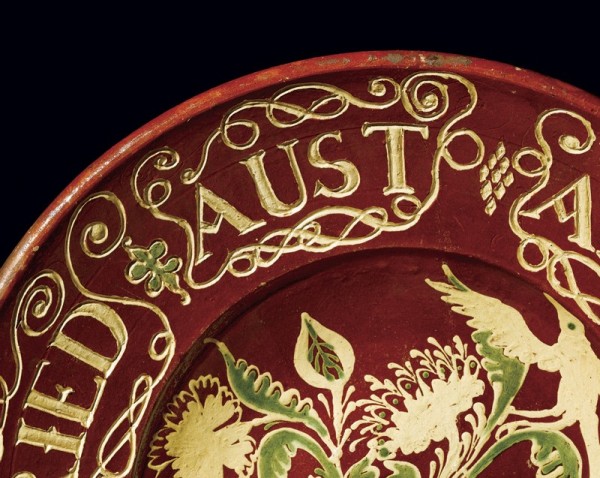
Detail of the decoration on the dish illustrated in fig. 25. Layout lines are visible above and below the letters.

Detail of the decoration on the dish illustrated in fig. 25.

Dish, Nevers, France, ca. 1685. Tin-glazed earthenware. D. 8 1/4". (Courtesy, Musée National de Céramique, Sèvres.)

Jan Davidsz de Heem, Vase of Flowers, Holland, ca. 1660. Oil on canvas. 27 3/8 x 22 1/4". (Courtesy, Board of Trustees, National Gallery of Art, Andrew W. Mellon Fund.)
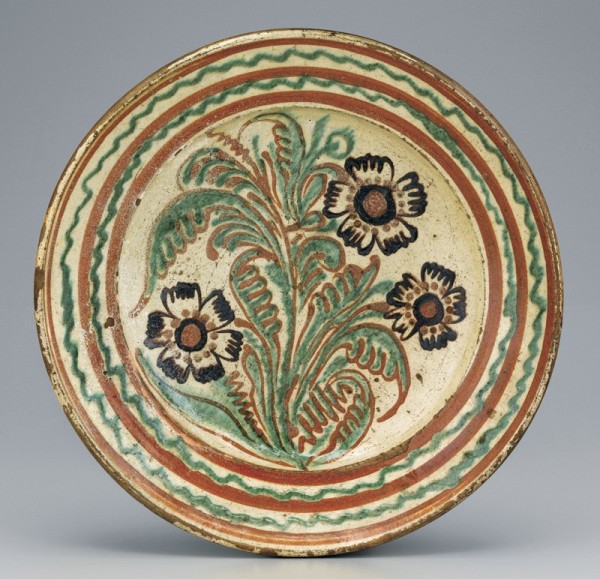
Dish, probably made during Aust’s tenure as master of the pottery at Salem, North Carolina, 1775–1785. Lead-glazed earthenware. D. 13 3/4". (Courtesy, Old Salem Museums & Gardens.) The flowers depicted on this dish are roses. Nearly identical representations of those flowers can be found in early botanical prints.

Dish, probably made during Aust’s tenure as master of the pottery at Salem, North Carolina, 1775–1785. Lead-glazed earthenware. D. 11 3/4". (Courtesy, The Barnes Foundation.)

Dish, probably made during Aust’s tenure as master of the pottery at Salem, North Carolina, 1775–1785. Lead-glazed earthenware. D. 13 3/4". (Courtesy, Old Salem Museums & Gardens.)
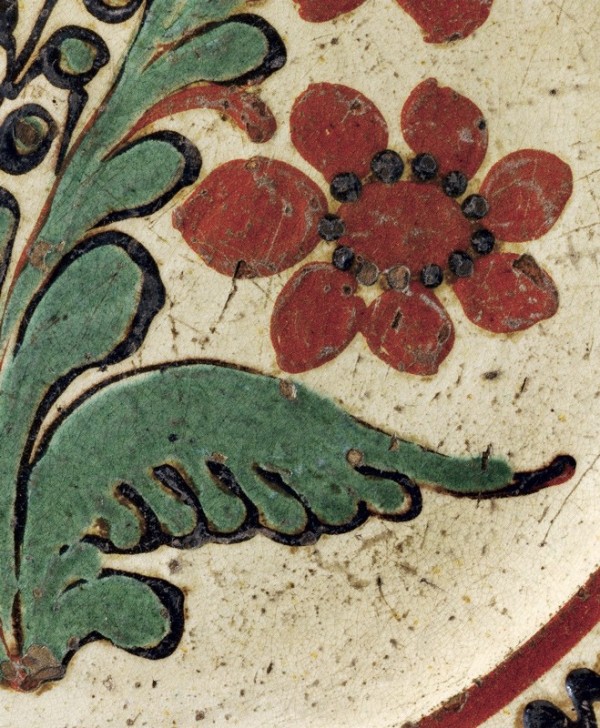
Detail of the decoration on the dish illustrated in fig. 32.
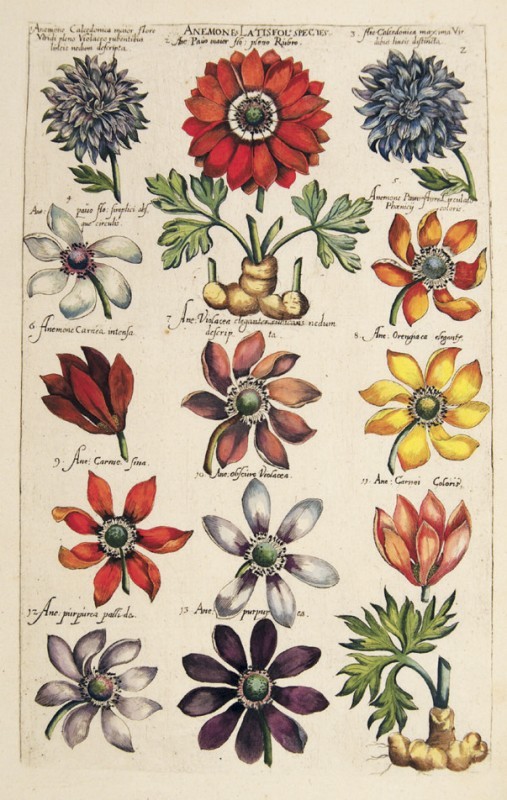
“Anemones Latisfol Species,” in Emanuel Sweerts, Florilegium amplissium et selectissimum, Amsterdam, 1647. Copperplate engraving with later color. 13 x 8 1/2". (Courtesy, Old Church Gallery, Chelsea, London.) Sweerts’s Florilegium was originally published in Frankfurt in 1612.
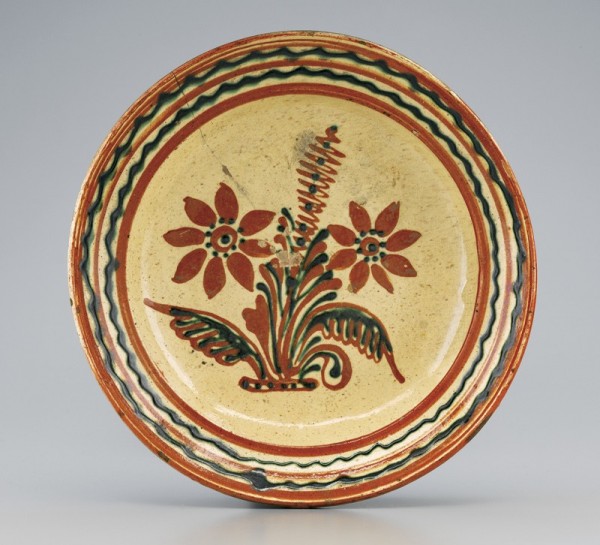
Dish, Salem, North Carolina, 1780–1800. Lead-glazed earthenware. D. 11 5/8". (Courtesy, Old Salem Museums & Gardens.)
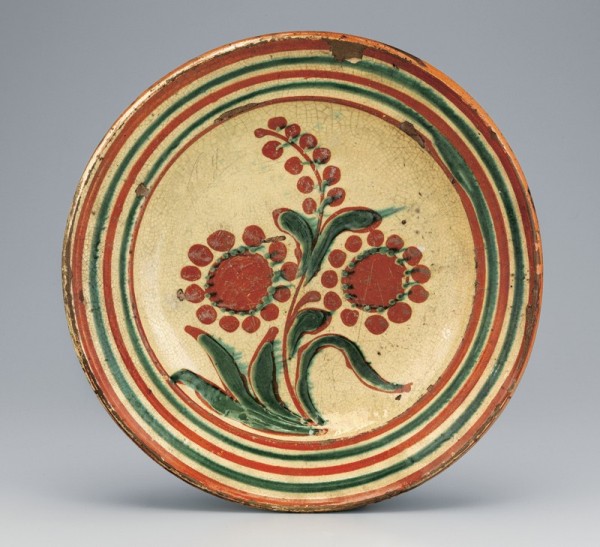
Dish, Salem, North Carolina, 1780–1800. Lead-glazed earthenware. D. 13 3/4". (Courtesy, Old Salem Museums & Gardens.)
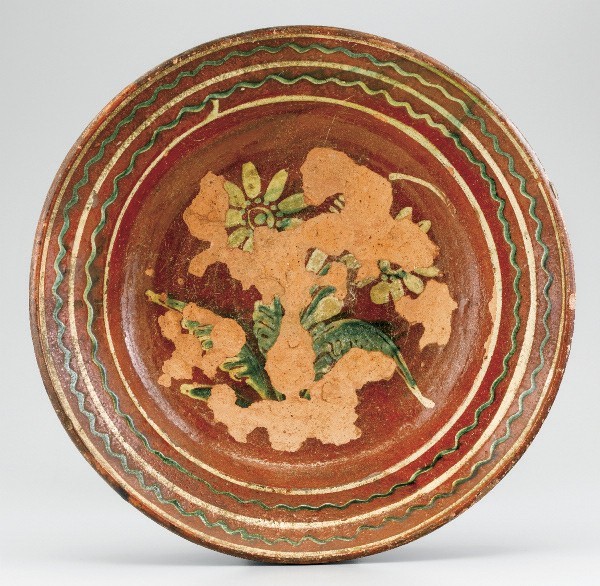
Dish, Salem, North Carolina, 1780–1800. Lead-glazed earthenware. D. 14 3/4". (Courtesy, Old Salem Museums & Gardens.) This dish descended in the Hall family of Salem.

Dish fragment, recovered at Salem, North Carolina, 1780–1800. Lead-glazed earthenware. (Courtesy, Old Salem Museums & Gardens.)
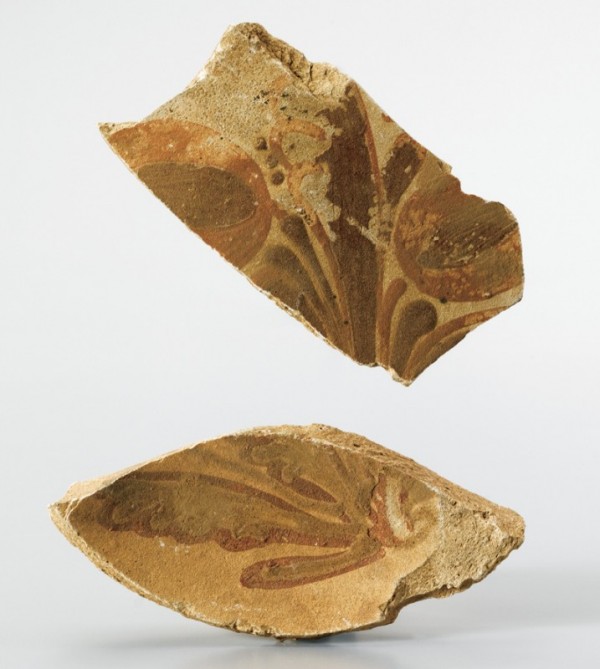
Dish fragments, recovered at Lot 49, Salem, North Carolina, 1780– 1800. Bisque-fired earthenware. (Courtesy, Old Salem Museums & Gardens.) Lot 49 was adjacent to the pottery.

Plate, Salem, North Carolina, 1780–1800. Lead-glazed earthenware. D. 9 1/4". (Courtesy, The Barnes Foundation.)
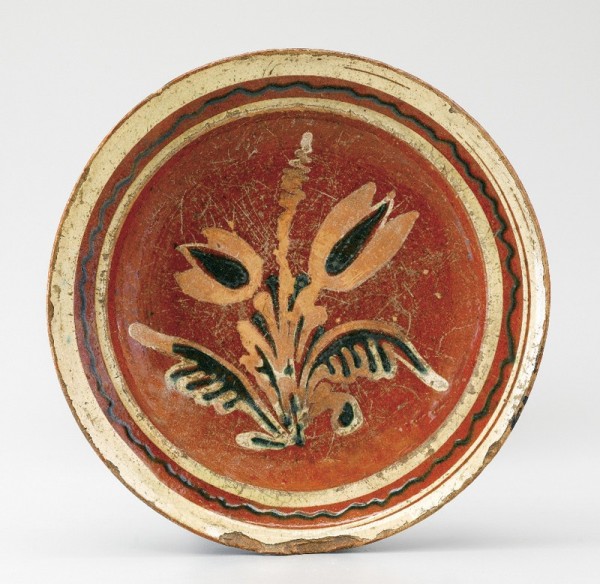
Plate, Salem, North Carolina, 1780–1800. Lead-glazed earthenware. D. 9 1/4". (Courtesy, The Barnes Foundation.)
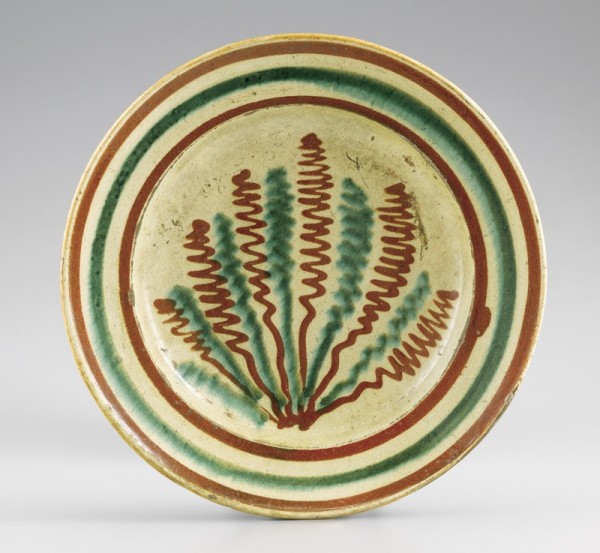
Dish, probably Salem, North Carolina, 1775–1800. Lead-glazed earthenware. D. 11". (Courtesy, Old Salem Museums & Gardens.) This dish and the example illustrated in fig. 43 descended in the Ellers family of Rowan County.

Dish, probably Salem, North Carolina, 1775–1800. Lead-glazed earthenware. D. 11". (Courtesy, Old Salem Museums & Gardens.) This dish and the example illustrated in fig. 42 descended in the Ellers family of Rowan County.

Dish, probably made during Aust’s tenure as master of the pottery at Salem, North Carolina, 1775–1785. Lead-glazed earthenware. D. 13". (Courtesy, The Henry Ford.)
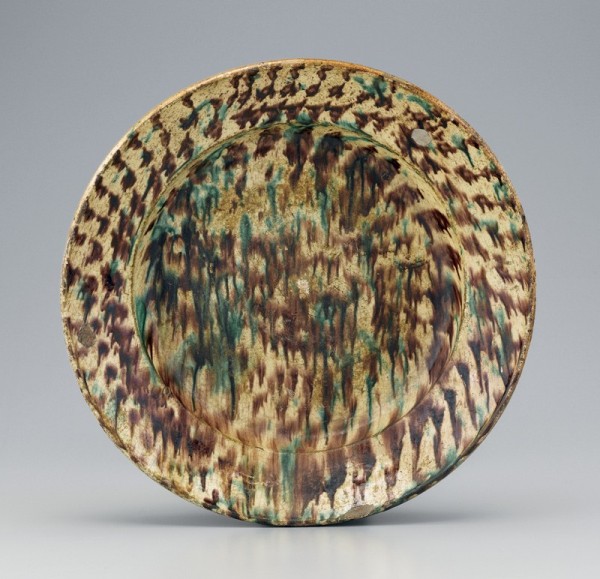
Dish, probably Salem, North Carolina, 1772–1820. D. 13". (Courtesy, Old Salem Museums & Gardens.)

Saucer and bowl, probably Salem, North Carolina, 1772–1820. D. 6 1/4" (saucer). (Courtesy, Old Salem Museums & Gardens.)

Sugar bowl, probably Salem, North Carolina, 1772–1820. H. 6". (Courtesy, High Museum of Art.)
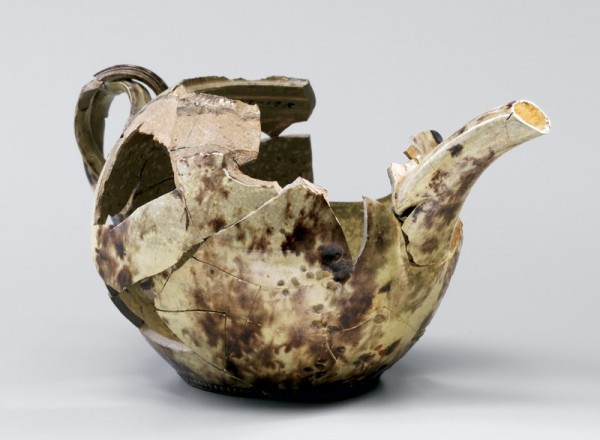
Teapot, recovered at Lot 49, Salem, North Carolina, 1774–1786. Lead-glazed earthenware. L. 7". (Courtesy, Old Salem Museums & Gardens.) This important object might have been produced by William Ellis during his 1774 visit to the Salem pottery or was a later creation of Rudolph Christ.

Sprig mold, Salem, North Carolina, ca. 1780. High-fired clay. L. 2". (Courtesy, Old Salem Museums & Gardens.) The back of this mold bears the initials “RC” for Rudolph Christ. Given the fact that the initials were cut after firing, it is possible that this mold is one of those Christ stole from the Salem pottery in 1779.

Teapot handle, recovered at Lot 49, Salem, North Carolina, 1774–1786. Lead-glazed earthenware. (Courtesy, Old Salem Museums & Gardens.) The teapot to which this handle belongs might have been produced by William Ellis during his 1774 visit to the Salem pottery or was a later creation of Rudolph Christ.

Plate mold, Rudolph Christ, Bethabara, North Carolina, 1789. Plaster. D. 10 7/8". (Courtesy, Wachovia Historical Society.)

Detail showing the inscription on the mold illustrated in fig. 51: “R. C / Bethabara / Jan. 6.~ / 1789.”
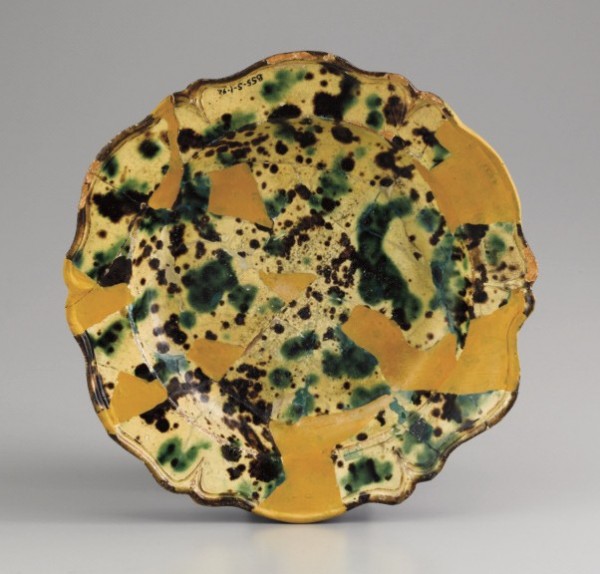
Dish, recovered at Rudolph Christ’s pottery site, Bethabara, North Carolina, 1786–1789. Lead-glazed earthenware. D. 9 3/4". (Courtesy, Historic Bethabara Park.)

Detail of the back of the dish illustrated in fig. 53.

Detail of the dish illustrated in fig. 53, showing the pink body and white slip.
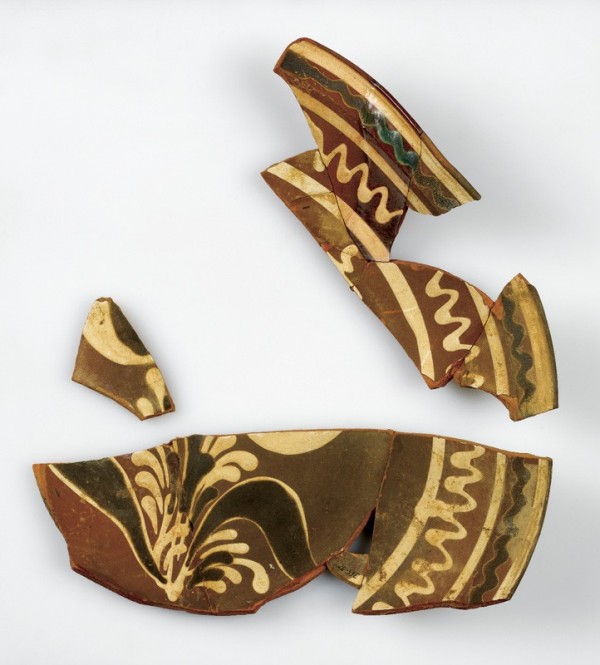
Dish fragments, recovered at Rudolph Christ’s pottery site, Bethabara, North Carolina, 1786–1789. Bisque-fired earthenware. (Courtesy, Old Salem Museums & Gardens.) A small amount of glaze, inadvertently dripped on the marly, shows how the outermost concentric and wavy slip lines would have appeared after firing.

Dish fragment, recovered at Rudolph Christ’s pottery site, Bethabara, North Carolina, 1786–1789. Bisque-fired earthenware. (Courtesy, Historic Bethabara Park.)
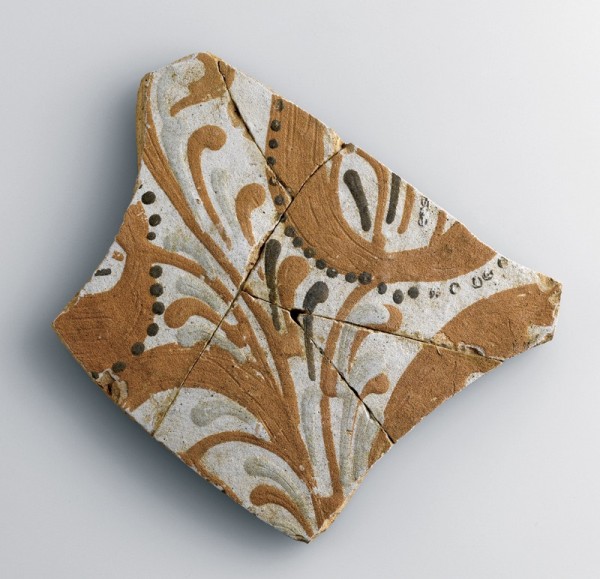
Dish fragment, recovered at the site of the gunsmith’s shop occupied by Rudolph Christ, Bethabara, North Carolina, 1786–1789. Bisque-fired earthenware. (Courtesy, Historic Bethabara Park.)
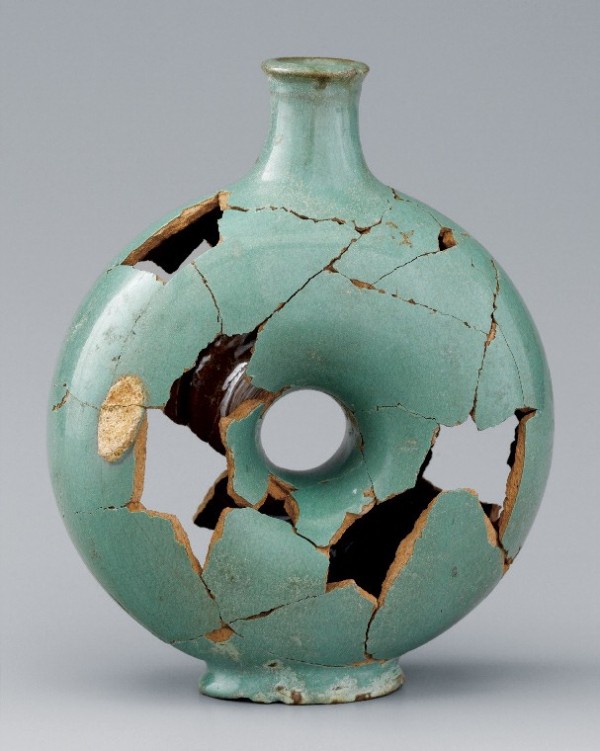
Ring bottle, recovered at Lot 49, Salem, North Carolina, 1793–1800. Tin-glazed earthenware. H. 7". (Courtesy, Old Salem Museums & Gardens.)

Plate fragments, recovered at Lot 49, Salem, North Carolina, 1793–1800. Tin-glazed earthenware. (Courtesy, Old Salem Museums & Gardens.)
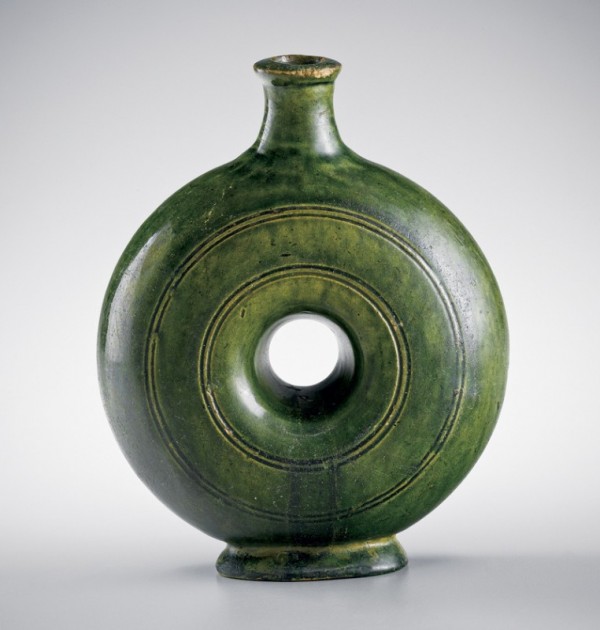
Ring bottle, Salem, North Carolina, 1795–1810. Lead-glazed earthenware. H. 4". (Private collection.)
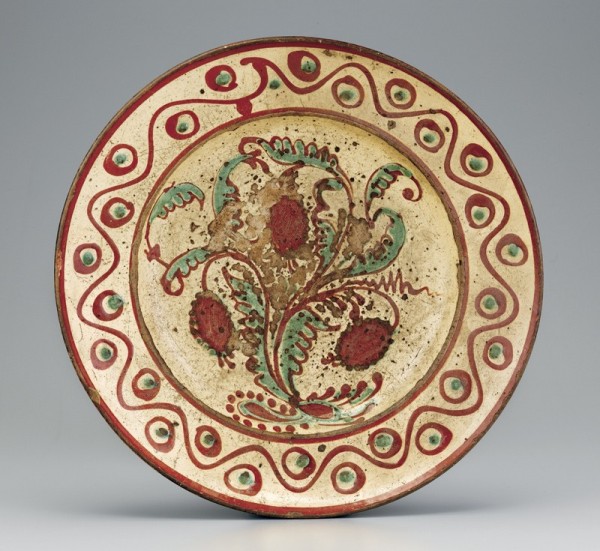
Dish, probably made during Rudolph Christ’s tenure as master of the pottery at Salem, North Carolina, 1790–1810. Lead-glazed earthenware. D. 13 1/2". (Courtesy, Old Salem Museums & Gardens.)

Dish, probably made during Rudolph Christ’s tenure as master of the pottery at Salem, North Carolina, 1790–1810. Lead-glazed earthenware. D. 12 1/2". (Courtesy, Old Salem Museums & Gardens.)
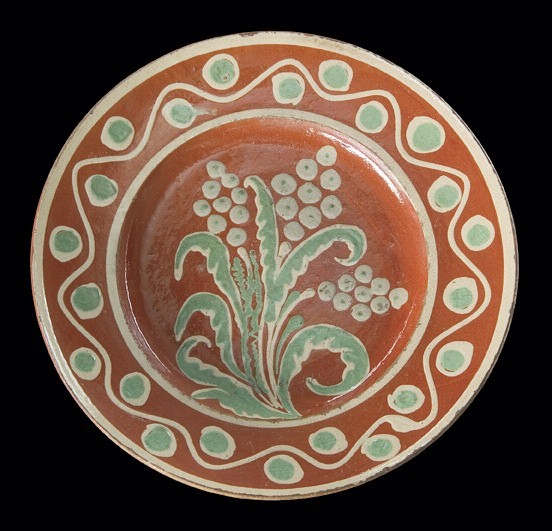
Dish, probably made during Rudolph Christ’s tenure as master of the pottery at Salem, North Carolina, 1790–1810. Lead-glazed earthenware. D. 14". (Private collection; photo, James and Nancy Glazer American Antiques.)
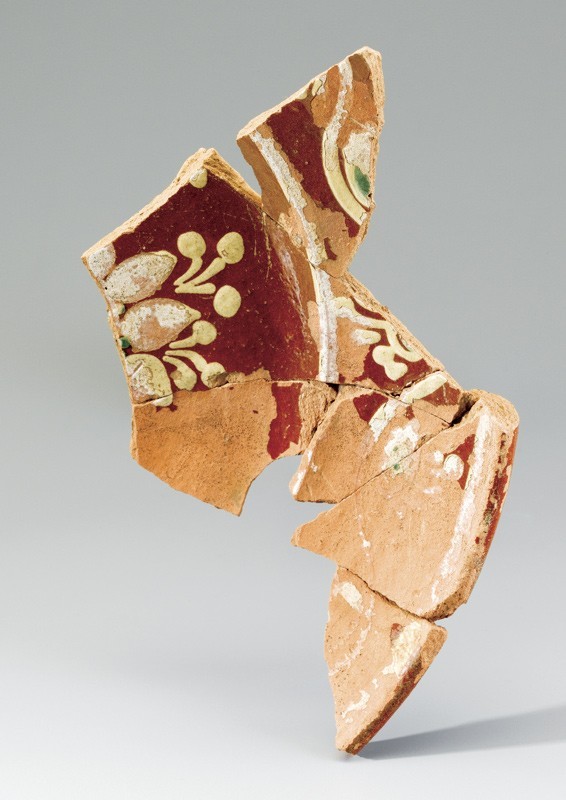
Dish fragment, Salem, North Carolina, 1790–1810. Lead-glazed earthenware. (Courtesy, Old Salem Museums & Gardens.)
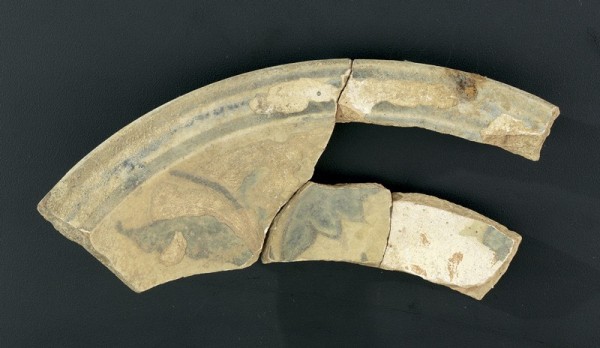
Dish fragment, Salem, North Carolina, 1790–1810. Lead-glazed earthenware. (Courtesy, Old Salem Museums & Gardens.)
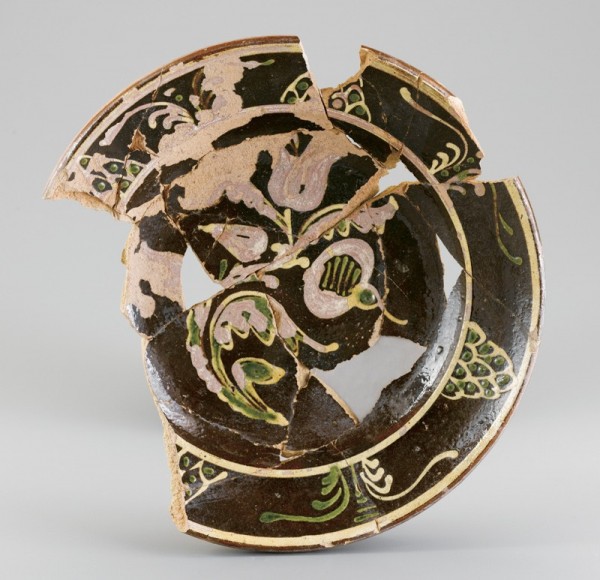
Dish, recovered at Lot 49, Salem, North Carolina, 1790–1810. Lead-glazed earthenware. D. 9 1/4". (Courtesy, Old Salem Museums & Gardens.)

Dish fragment, recovered at Gottfried Aust’s pottery site, Bethabara, North Carolina, 1756–1770. Bisque-fired earthenware. (Courtesy, Old Salem Museums & Gardens.)
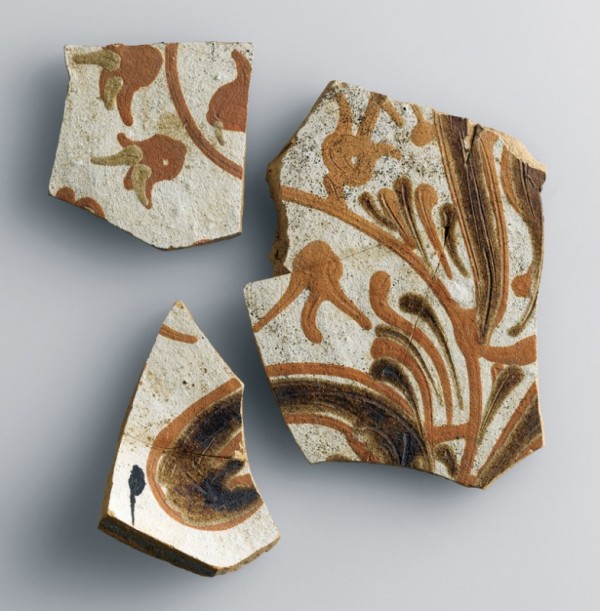
Dish fragments, recovered at the site of Gottlob Krause’s pottery, Bethabara, North Carolina, 1790–1800. Bisque-fired earthenware. (Courtesy, Historic Bethabara Park.)
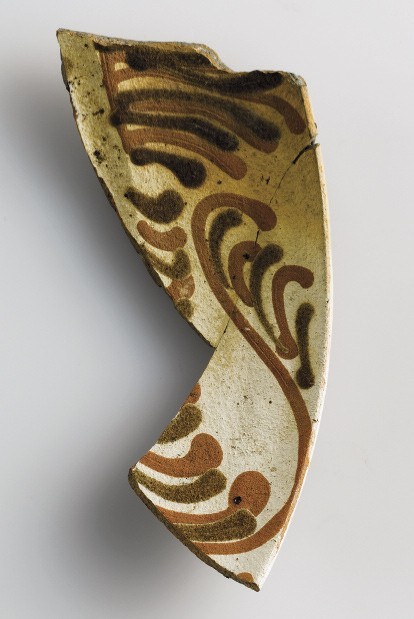
Dish fragment, recovered at the site of Gottlob Krause’s pottery, Bethabara, North Carolina, 1790–1800. Bisque-fired earthenware. (Courtesy, Historic Bethabara Park.)
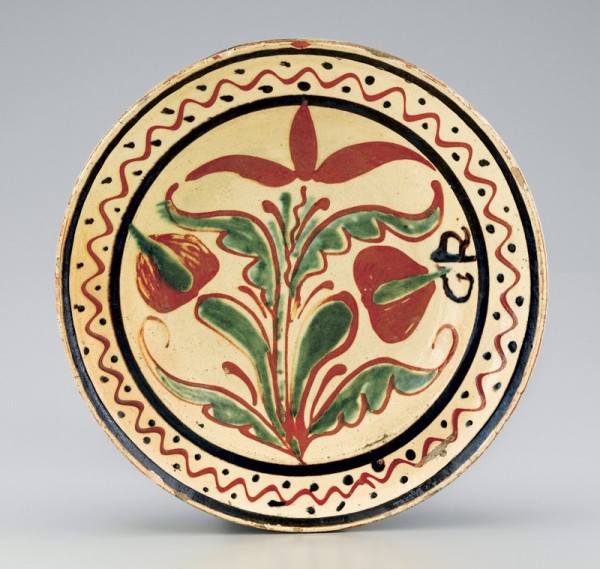
Dish, Friedrich Rothrock, Forsyth County, North Carolina, 1793–1800. Lead-glazed earthenware. D. 11 5/8". (Courtesy, Old Salem Museums & Gardens.)
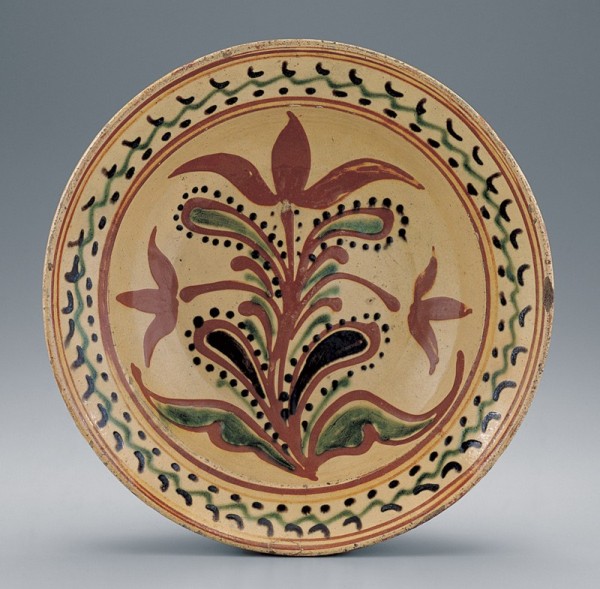
Dish, Friedrich Rothrock, Forsyth County, North Carolina, 1793–1800. Lead-glazed earthenware. D. 11". (Private collection.)

Jug, Friedrich Rothrock, Forsyth County, North Carolina, 1793–1800. Lead-glazed earthenware. H. 9 3/4". (Private collection.)
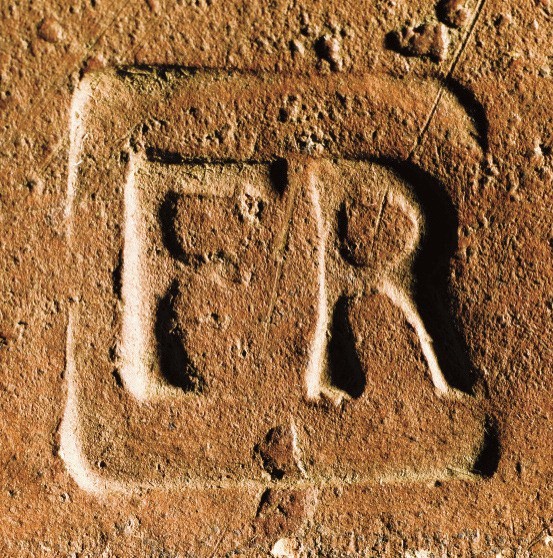
Detail of the dish illustrated in fig. 71, showing the impressed mark on the back.
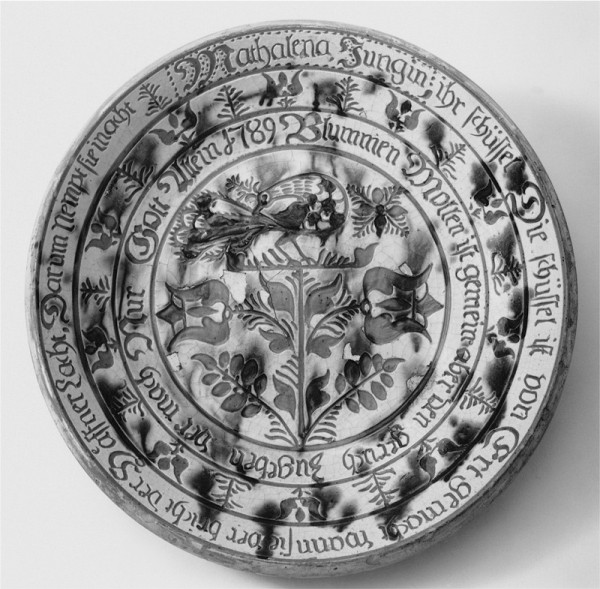
Dish, attributed to George Hubener, Montgomery County, Pennsylvania, 1789. Lead-glazed earthenware. D. 12 1/2". (Courtesy, Philadelphia Museum of Art; gift of John T. Morris.)

Hendrick Goltzius, Youth with a Skull and a Tulip, Holland, 1614. Ink on paper. 18 1/2 x 13 7/8". (Courtesy, The Pierpont Morgan Library, New York.)
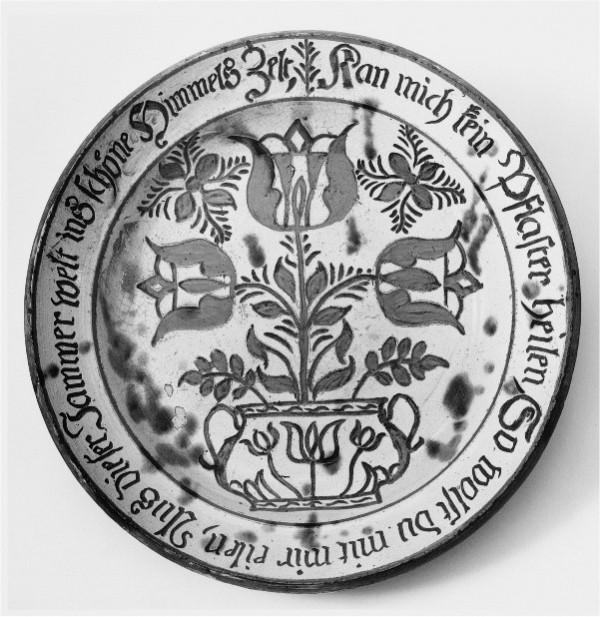
Dish, attributed to George Hubener, Montgomery County, Pennsylvania, ca. 1785. Lead-glazed earthenware. D. 12 1/2". (Courtesy, Philadelphia Museum of Art; Baugh-Barber Fund.)

Hans Memling, Flower Still-Life, Holland, ca. 1485. Oil on oak panel. 11 1/2 x 8 7/8". (Courtesy, Museo Thyssen-Bornemisza, Madrid.)
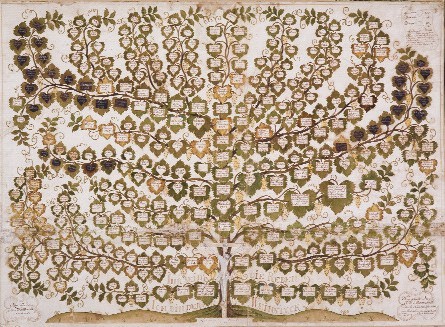
Illuminated manuscript, designed by Friedrich von Watteville and executed by P. J. Ferber, Herrnhut, Germany, 1775. Ink and watercolor on paper. 27 x 37". (Courtesy, Old Salem Museums & Gardens.)
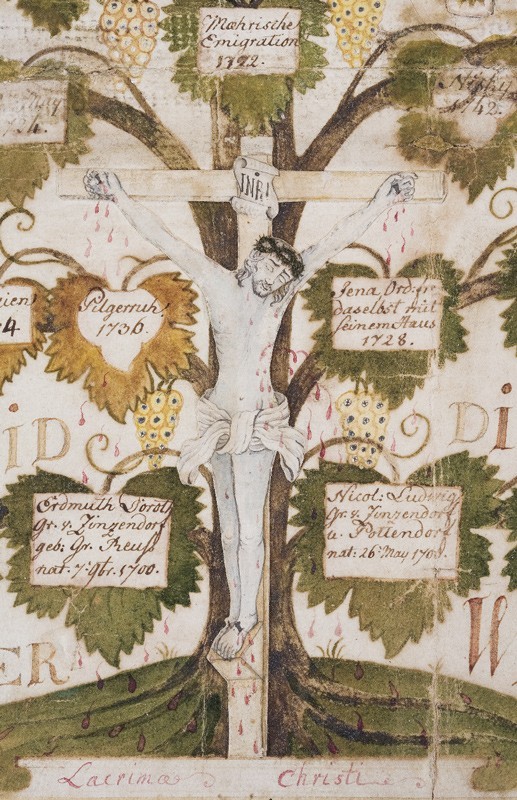
Detail of the illuminated manuscript illustrated in fig. 79.
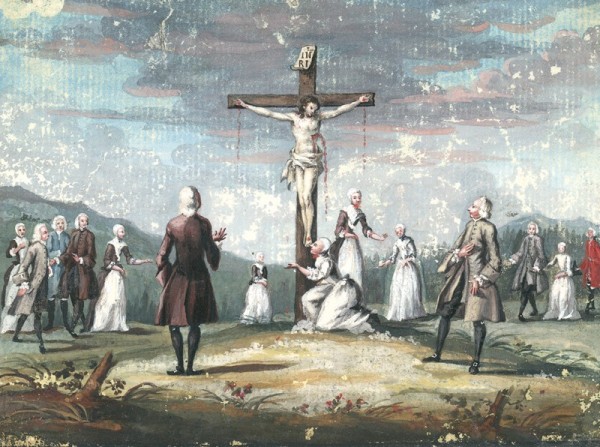
Unknown artist, painting depicting the Crucifixion of Christ, Herrnhut, Germany, ca. 1750. Watercolor on paper. Dimensions not recorded. (Courtesy, Unity Archives, Herrnhut.)
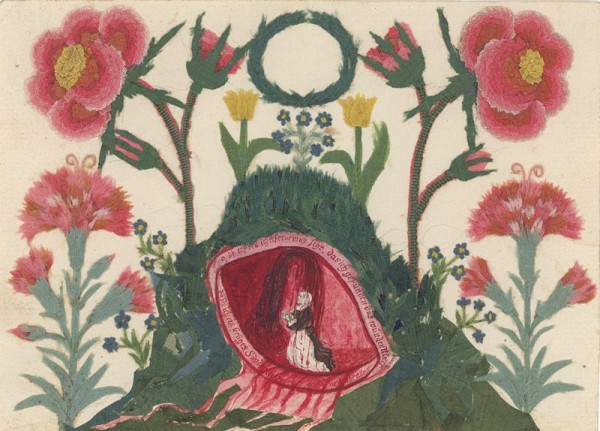
Unknown artist, devotional card, Herrnhut, Germany, ca. 1750. Watercolor and thread on paper. Dimensions not recorded. (Courtesy, Unity Archives, Herrnhut.)

Dish, probably made during Aust’s tenure as master of the pottery at Salem, North Carolina, 1775–1785. Lead-glazed earthenware. D. 14 1/8". (Courtesy, High Museum of Art.)
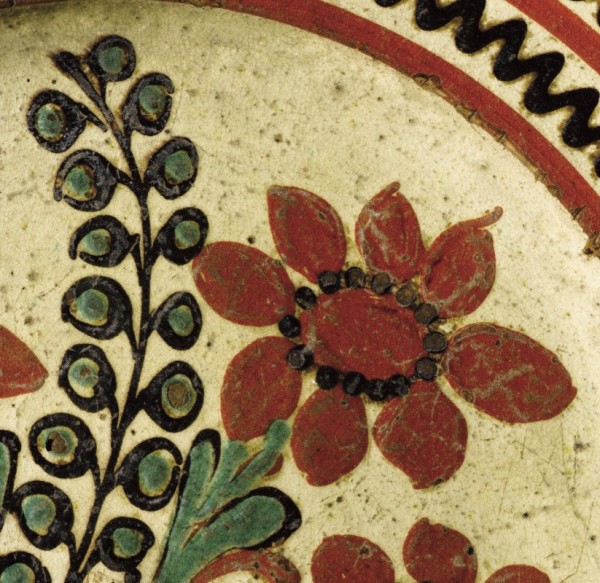
Detail of the decoration on the dish illustrated in fig. 32. The round, podlike designs on the stem probably were intended to represent lilies of the valley, which also appear on the dish fragments illustrated in fig. 69.
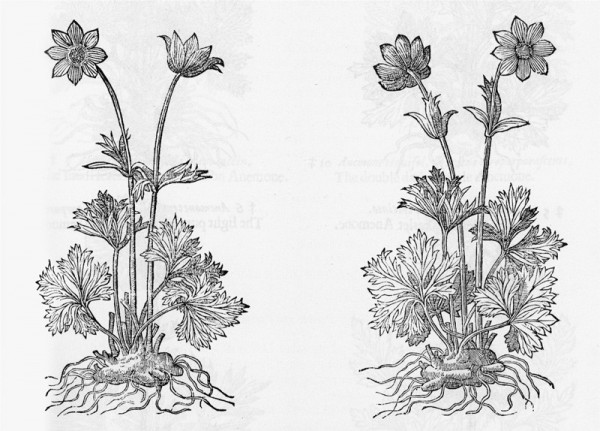
Period botanical showing red anemones. (John Gerard, The Herbal: or, General History of Plants [1633; repr., New York: Dover Publications, 1975], p. 379.)
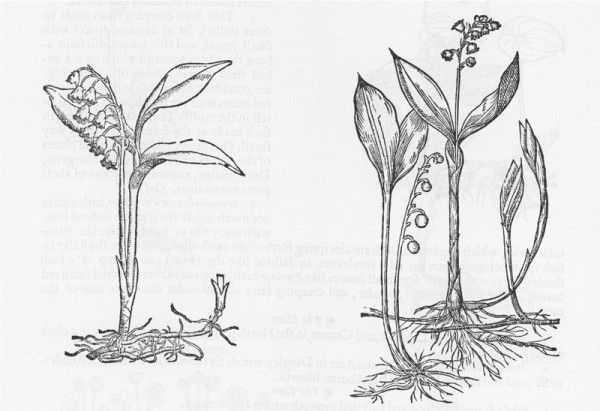
Period botanical showing lilies of the valley. (Gerard, The Herbal, p. 410.)
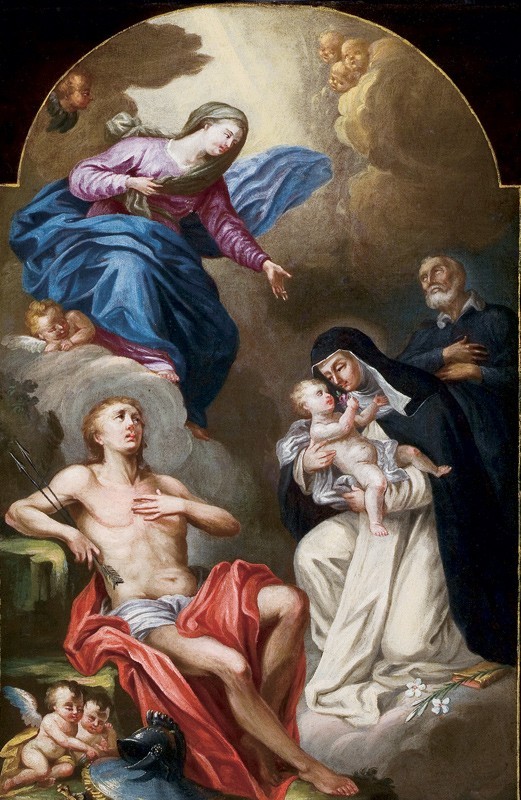
John Valentine Haidt, Cornelius Foreseeing His Christianity, Bethlehem, Pennsylvania, ca. 1755. Oil on canvas. 24 5/8 x 20". (Courtesy, Old Salem Museums & Gardens.) Haidt’s paintings were used as educational tools in Moravian congregations throughout Europe and America. The flowers illustrated in this painting were symbolically charged, as suggested by the rose held by the Christ Child as he gazes into his mother’s eyes. In Christian theology, Christ is described as the rose among thorns and Mary as the rose without thorns. Roses also served as symbols for the messianic promise and the Virgin Mary. Not surprisingly, roses are common on eighteenth-century Wachovia slipware (see fig. 30).
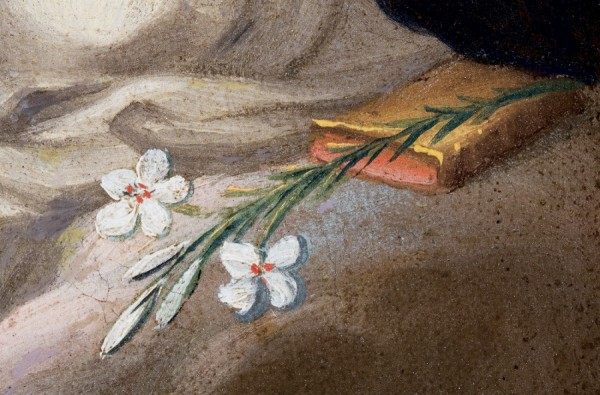
Detail of the white anemone in the foreground of the painting illustrated in fig. 87.

Detail of a flower on the dish illustrated in fig. 63.

Raffaellino del Garbo, Madonna Enthroned with Saints and Angels, Italy, 1502. Oil on panel. 78 x 82 1/2". (Courtesy, Fine Arts Museums of San Francisco; gift of the Samuel Kress Foundation.)

Sandro Botticelli, Madonna of the Pomegranate, ca. 1487. Tempera on wood panel. D. 56 1/2". (Courtesy, Galleria degli Uffizi, Florence.)

Dish fragment, recovered from an unidentified cellar, Bethabara, North Carolina, 1760–1770. Lead-glazed earthenware. (Courtesy, Historic Bethabara Park.)

Composite illustration showing different representations of pomegranates in Bethabara and Salem slipware. The details are taken from the dish fragment illustrated in fig. 92 (left), the dish illustrated in fig. 67 (middle), and the dish illustrated in fig. 62 (right ).

Dish, probably made during Rudolph Christ’s tenure as master of the pottery at Salem, North Carolina, 1790–1810. Lead-glazed earthenware. D. 15 1/2". (Courtesy, The Barnes Foundation.)
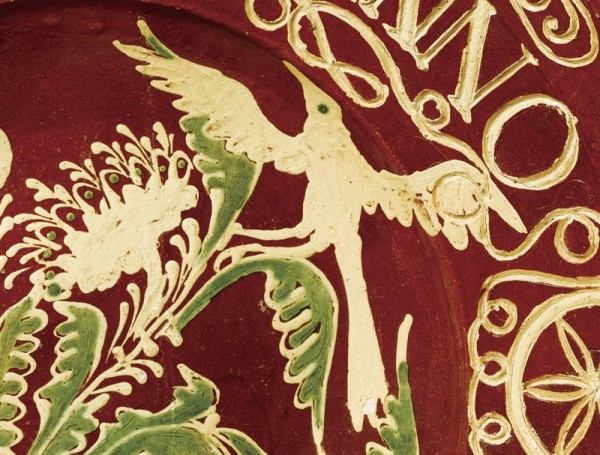
Detail of the decoration on the shop sign illustrated in fig. 25.

Unknown artist, devotional card, Herrnhut, Germany, ca. 1750. Watercolor on paper. Dimensions not recorded. (Courtesy, Unity Archives, Herrnhut.)
